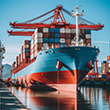The logistics industry stands at a critical juncture, facing unprecedented challenges that test the resilience, adaptability, and innovation of supply chain professionals. This comprehensive exploration delves into the top 10 challenges currently shaping the logistics landscape.
1. Technology Integration and Digital Transformation
The rapid evolution of technological solutions presents both an opportunity and a significant challenge for logistics companies:
- Complex Technology Adoption: Integrating advanced technologies like artificial intelligence, Internet of Things (IoT), and blockchain requires substantial investment and organizational change.
- Skill Gap: Finding and training professionals who can effectively manage and implement cutting-edge logistics technologies.
- Legacy System Constraints: Overcoming the limitations of existing infrastructure while transitioning to more advanced digital platforms.
2. Sustainability and Environmental Regulations
Environmental concerns are dramatically reshaping logistics strategies:
- Carbon Emission Reduction: Developing and implementing strategies to minimize carbon footprint across transportation and warehousing.
- Regulatory Compliance: Navigating increasingly stringent environmental regulations across different global markets.
- Green Technology Investment: Balancing the cost of sustainable technologies with operational efficiency and profitability.
3. Global Supply Chain Volatility
Ongoing global uncertainties continue to challenge supply chain stability:
- Geopolitical Disruptions: Managing risks associated with trade tensions, political instability, and regional conflicts.
- Pandemic-Induced Uncertainties: Continuing to adapt to lingering supply chain disruptions and potential future global health challenges.
- Market Unpredictability: Developing agile strategies to respond to rapid market changes and unexpected global events.
4. Workforce Challenges and Talent Management
The logistics sector faces critical human resource challenges:
- Skilled Labor Shortage: Addressing the growing gap in specialized logistics and supply chain expertise.
- Workforce Retention: Developing strategies to attract and retain talented professionals in a competitive job market.
- Generational Workforce Transition: Bridging the gap between traditional logistics practices and the expectations of younger workers.
5. Cybersecurity and Data Protection
As logistics becomes increasingly digital, security challenges intensify:
- Sophisticated Cyber Threats: Protecting complex, interconnected logistics networks from evolving cyber risks.
- Data Privacy Compliance: Navigating international data protection regulations and ensuring robust security measures.
- Technology Vulnerability: Securing multiple touchpoints in increasingly complex supply chain ecosystems.
6. Last-Mile Delivery Complexity
The final stage of delivery continues to pose significant challenges:
- Urban Delivery Constraints: Addressing challenges in dense urban environments with complex delivery requirements.
- Customer Expectation Management: Meeting increasingly demanding consumer expectations for speed and convenience.
- Cost-Effective Solutions: Developing efficient last-mile delivery strategies that balance customer satisfaction with operational costs.
7. Transportation Cost Management
Rising transportation costs create ongoing challenges:
- Fuel Price Volatility: Developing strategies to mitigate the impact of fluctuating fuel prices.
- Infrastructure Limitations: Addressing challenges related to transportation infrastructure and capacity constraints.
- Alternative Transportation Solutions: Exploring and implementing more cost-effective and sustainable transportation methods.
8. Inventory Management and Optimization
Balancing inventory levels remains a critical challenge:
- Demand Forecasting: Improving predictive capabilities to optimize inventory levels.
- Just-in-Time vs. Safety Stock: Navigating the delicate balance between lean inventory and risk mitigation.
- Technology-Driven Inventory Solutions: Leveraging advanced analytics and AI for more precise inventory management.
9. Regulatory Compliance and Global Trade Complexities
Navigating the intricate landscape of international trade regulations:
- Customs Complexity: Managing increasingly complex customs requirements across different global markets.
- Regulatory Adaptation: Staying current with rapidly changing international trade policies and regulations.
- Compliance Cost Management: Balancing the cost of compliance with operational efficiency.
10. Customer Experience and Technological Expectations
Meeting evolving customer demands in a digital age:
- Real-Time Tracking: Providing comprehensive, transparent, and instantaneous shipment visibility.
- Personalization: Developing more customized logistics solutions to meet specific customer needs.
- Seamless Technology Integration: Creating intuitive, user-friendly interfaces for customer interaction.
Conclusion: Turning Challenges into Opportunities
The logistics industry’s future belongs to those who can transform these challenges into strategic advantages. Success will require a holistic approach that combines technological innovation, strategic thinking, and human-centric solutions.
Key Insight: The most successful logistics organizations will be those that view these challenges not as obstacles, but as opportunities for innovation, differentiation, and strategic growth.






